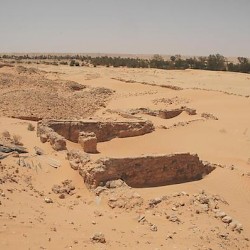Gholaia (Bu Njem) (2)
Gholaia: Roman fort, part of the Limes Tripolitanus, modern Bu Njem.
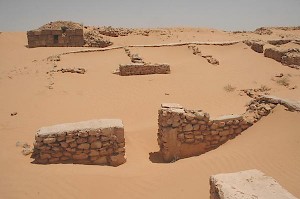
The Praetorium, the residence of the commander, consisted of several parts. There was a hall that gave access to four rooms in the south and three in the north. Beyond it was an open space (visible behind the Praetorium, partly covered with stones), and a store room (of which the remains are only just visible above the surface). The open space may have been a garden with some palm trees.

A graffito from the bathhouse, made by a very capable artist, shows the fort, with the Porta Praetoria in front and two gates to the left and right. The two towers left of the main entrance are the Praetorium, the column to the right must have been some sort of monument. The small structure between the two towers of the main gate must be the Principia.
The drawing shows the Praetorium as a high building with two tower-like structures. There may have been an additional floor. Still, compared to similar buildings, the Praetorium of Gholaia was a modest one. It did not matter very much, because the commander must have received his guests in the garden. Even in the winter, it is hot in Libya, and when it rains, that's a reason to enjoy it.
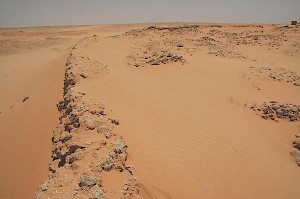
The walls surrounded an area that was 135 m long and 90 m wide (270 x 180 Punic cubits). As you can see on this picture of the southern part of the western wall, there were no towers on the corners of the fort. This is remarkable, because towers were a normal feature in the standard fort. It becomes even more remarkable when we take a look at a graffito that was discovered in the bathhouse of Gholaia.
The southern gate (Porta principalis dextra), of which only the foundations survive, once had a large arch, on top of which was an inscription that recorded the building, which appears to have started on 24 January 201. The commander in charge was a man named Julius Dignus. Next year, the emperor, Septimius Severus, personally inspected the newly founded forts of the Limes Tripolitanus.
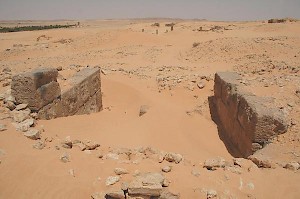
The western gate, or Porta decumana is known from a drawing by the French traveler G.F. Lyon, which also shows a part of the battlemented northern wall. The lower part, which we still see today, was made of natural stone, whereas the upper part was made of bricks. Each tower offered space for at least six catapults, on three floors. The other gates must have been identical.
The archaeologists found some of the barracks, where units of eight men (contubernia) must have slept (if they did not prefer to sleep on the roof). It is a bit odd that there accommodation for seven contubernia, fifty-six men, per block only, whereas eighty would be the normal number of people in a block. There were twelve blocks, so there must have been 672 soldiers: one cohors and an auxiliary unit.
The remains of the buildings in the northwestern sector have not been identified. Perhaps, they were stables for horses and dromedaries, because they have not been identified somewhere else. And without cavalry, it would be impossible to pursue attacking nomads.

Close to the northern gate was the bathhouse, which was erected in 202 by commander Quintus Avidius Quintianus. In one of the rooms, the graffito shown above was discovered. Often, Roman thermae had three types of bath: cold, tepid, and warm. It seems that Gholaia had two baths. The building also had a latrine.
The wood for the fire must have been cut in the oasis, and this was obviously an important job. Ostracon #36 mentions a soldier sent away to get wood, and Ostracon #5 mentions soldiers who are sent to the bathhouse, where they obviously had some work to do.
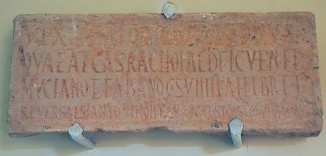
North of the northern gate (Porta principalis sinistra) was the civil settlement (vicus). From the ostraca, we know that there were temples and a dromedary station (Ostracon #5). The vicus appears to have been pretty large, because you can find sherds in a wide area surrounding the fort. A temple of the Libyan god Ammon and something resembling a shopping mall have been excavated.
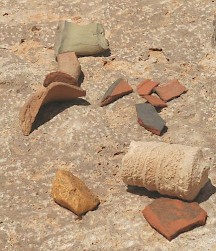
Surface finds to the north and east, but also in the west and southwest of the fort prove that the vicus surrounded the military settlement on nearly all sides; aerial photos suggest that the eastern part was surrounded by a wall.
You can recognize several types of pottery. The different colors prove that they were made from different types of clay, which means that the potters lived on different locations. It proves that Gholaia, although situated on the southern frontier of the Roman Empire, was well-connected to interregional trade. The greenish jar handle betrays silty clay and was produced somewhere along the sea shore. In the southeastern part of the vicus, we found several pieces of mica, which resembles glass and was a great luxury. In that area, the necropolis has been identified, to the south of the oasis, in the direction of the desert. Perhaps the mica belonged to an expensive funeral gift.
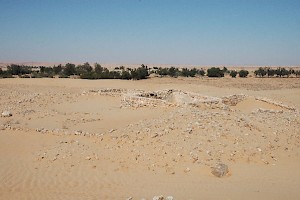
About the soldiers' lives and opinions, hardly anything is known, but it is interesting to note that east of fort Gholaia, the legionaries erected a temple dedicated to Cannaphar, a Libyan war god identified with Mars. An inscription survives and explicitly mentions that the building was erected in 225 by legionaries of III Augusta. It is now in the museum of Lepcis Magna. The names of the emperor Severus Alexander and his detested mother Julia Mamaea were erased after they had been killed in 235.
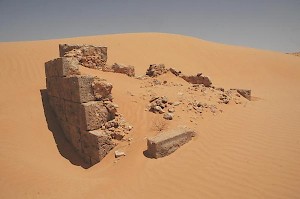
The dominant wind, the ghibli, is from the south, which explains why so much sand is covering the outside of the fort. In the distance, you can see the main road from Bu Njem to the Jofra oases and a water tower that is close to the wells that the Gholaia fort had to protect. The waters smell of sulfur.
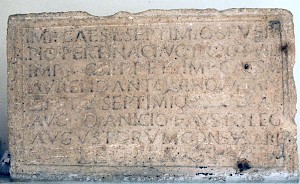
The fort was probably abandoned in the early 260s. However, the Bu Njem oasis was too important to be left unguarded. Byzantine and Arab armies occupied the site and this small fort is a reminder of the Italian presence. If you want to visit Gholaia, Fortina Capitano di Mondato is probably your best point of reference. It is immediately south of the oasis, along the road to Jofra oases. The Roman fort is about 800 meter to the east from the Italian castle.
It is surprising that today's people of the Bu Njem oasis are almost unaware of the existence of Gholaia. When we asked for directions, we were sent to the west, where, after ten kilometers, we should ask for more information. This is the correct road, but to the wrong Roman site: Ghirza.






